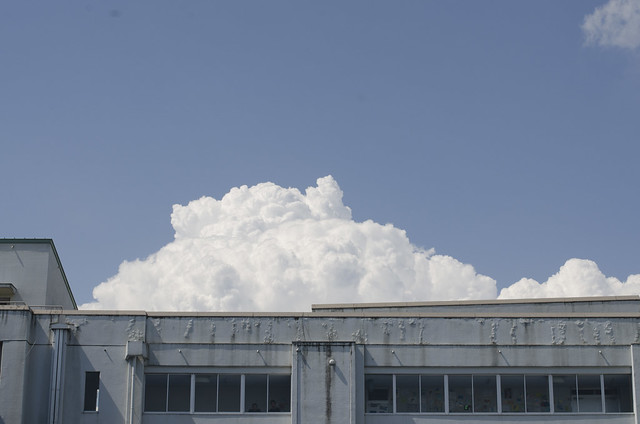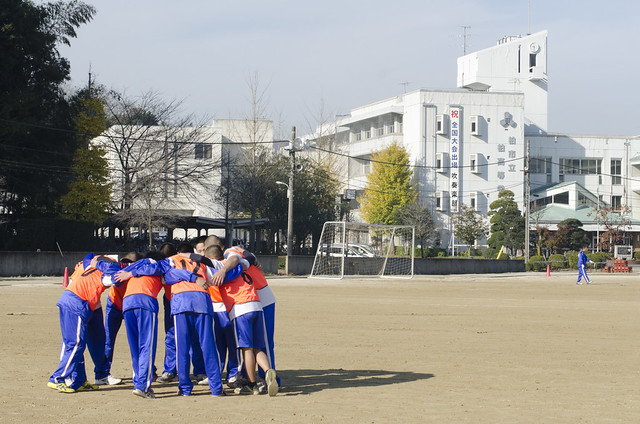1That's カシュー to you and me.
1, Kashiwa Municipal High School (Ichikashi) has seen 40 different exchange teachers since the program's institution in 1979.As Matthew and I enter into the second year of the fortieth cycle of the Teaching Exchange Program, especially in respect to the upcoming 40th anniversary celebration, we have taken a bit of time to look back at how things have changed since the late 1970s.
At the center of our program still remains cultural exchange and language training. The preponderance of our curriculum focuses on general composition for third-year students, as well as advanced-level preparatory college language training for exams and interviews. Additionally, we instruct two separate units of oral communication for specific purposes for second-year students, the first being an elective general study, while the second is an intensive language training class for Ichikashi's second-year International Studies course (国際科) and their corresponding school excursion to America in November.
Since arriving in Kashiwa to assume my post at the head of these classes, I have continually been astounded by the incredible level of support that we receive from our administration. For all the passion the city has at the political level for the Teaching Exchange Program, the practicalities are a burden to bear upon the heart of the local administration for hosting the exchange teachers. And here at Ichikashi, we have been blessed to have had Mr. Hideonobu Suda as principal (校長) for the last three years.
It has been Suda-先生's goal in his tenure at Kashiwa Municipal to increase the exposure and impact of exchange programs upon Ichikashi's student body. Since his arrival, he has made it a priority to ensure the viability of Ichikashi's student exchange programs, not just with Torrance, but with their sister cities in Australia and China.

Likewise, it has been under Suda-先生's guidance that the Kashiwa Teaching Exchange Program has undergone it's most drastic transformation away from assistant language teaching.
Whereas in the old days, all classes would be taught in tandem with a Japanese language-native homeroom teacher, currently the Exchange Program instructors conduct classes without the assistance of such a "JLT," leading lessons of their own design, transitioning the role from an "Assistant Language Teacher" to a full-fledged "English Language Teacher." In fact, many of Ichikashi's flagship programs for the International Course, such as the annual English Camp, have been placed completely under the purview of the ELTs.
Over the years, the Teaching Exchange Program has provided Ichikashi with a high level of student output, by palpably increasing student performance in standardized tests, in addition to helping to place graduates in international schools and prestigious universities throughout Japan, all while maintaining national excellence in sports and the arts.
Since 2005, we have had 208 students take and pass at least one of any of the five levels of the Eiken English Proficiency Exam. And while the overall number of our students who pass any level of the Eiken has declined recently (from 29 and 34 in 2005 and '06 to 19 and 25 in 2010 and '11), the percentage of students who have taken and passed the highest levels of the Eiken (for our purposes, Pre-1st and 2nd Grade) has gradually been increasing. There is a thought that the curriculum change in 2009 to accommodate a larger emphasis on sports clubs has adversely affected interest and preparation for the Eiken. However, the proportion of students who successfully take Eiken Grade-2--the language requirement for second-tier schools such as Kanda--has remained relatively consistent throughout the years.
Similarly, over the last four years there has been an increase in the number of students (82.7% - 87.4%, +4.7%) who attend college after leaving Ichikashi (either a 4-year college, 2-year college, or specialty vocational/trade school--専門学校), including an upward trend within the Foreign Language Department (80.4% - 92.5%, +12.1%)
2Fun fact: the Sports Science Course (スポーツ科学科), the second of the two specialty courses offered at Ichikashi, placed 91.2% of it's students last year in college.
2.Upon matriculation, with regularity, these students can expect to be prepared with an education worthy of entrance into the top 25-30th percentile of private universities in Japan, which includes acceptance to schools such as Kanda Gaigo and Komazawa, with many of our top students finding acceptance in top-tier universities, including admission to Aoyama Gakkuin, Tokodai and Waseda.

Figuring that the effectiveness of the program is rooted in the cultural experience of an American-education sensibility in consultation with the copious native resources at the English language teachers' disposal, such consistent, high-level output has been rewarded, administratively, with trust and a hands-off approach. And while this may be the dream arrangement for many educators, often it is not without struggle and confusion for the ELTs, some of whom arrive at the front doors of Ichikashi with very limited experience in lesson or program planning.
Even more so, such institutional freedom is not limited to the academic aspect of high school education. Once settled into the routine of lesson planning, teaching, and managing the campus English Conversation Club, the ELTs are encouraged to pursue as many avenues for cultural exchange and education for personal growth as time would allow.
Not only do we find a ready conversation in English with the 11 other teachers in the Foreign Language Department
3Fun fact: Ichikashi is one of the few schools in all of Chiba that offers a Chinese Language Program. In addition to having one full-time Chinese teacher in residence, we also host 2 part-time Chinese ALTs.
3, just about everyone on campus is more than willing to share with us their little piece of Japan, whether that be their slice of the office in the home economics hall, weekly contemplation on their hobbies and crafts like 書道 or 生け花, or personal travel recommendations for trips to and around hometowns. It is actively promoted that we ingratiate ourselves into the communal fabric of Ichikashi, and not just in the teachers' office. If given the interest and wherewithal, Ichikashi ELTs are highly encouraged and soundly welcomed to incorporate themselves into club activities. My predecessor, Geoff, regularly participated in basketball practices and even Matthew has begun contemplating visiting the volleyball club at the request of the boys’ head volleyball coach. I find myself in the 柔道場 most weekdays and just about every weekend, where my duties include assisting the coach with clerical duties and chaperoning, impromptu English quizzes in vocabulary and culture, and even training for my own 黒帯試合.
For as much as this opportunity continues to offer us personal and professional challenges that will undoubtedly benefit us in whatever careers we pursue in the near future, it is our desire to do our part to ensure that the Exchange Teaching Program continues to grow, as the campus itself continues to expand with new classrooms and athletic facilities to suit the ever changing needs of education in the twenty-first century.
Certainly, Ichikashi has long been an attractive destination among Kanto high schools for its specialty clubs, drawing students from all over Chiba and Tokyo for sports and music
4Fun fact: 1/5th of our student body belongs to 吹奏楽部.
4, some who commute two hours by bike, train and bus from places like Tokyo to come to Ichikashi. Ichikashi is also well positioned to take advantage of its unique access to resources in terms of English language and intercultural exchange, and as such, we look to continue to challenge the ELT program to grow into an international-education program befitting a campus of Ichikashi's stature. In addition to attempting to solidify a reusable lesson cycle for the composition and oral communication courses, a main target we have is to see the expansion of the ELTs and the English Conversation Club footprint locally and in the broader Kashiwa community. For example, at school, twice a week we lead "Lunch with Kevin and Matthew," a focused English conversation opportunity for every student enrolled in the International Course. Recently, we have tasked the ECC with leading these discussions, creating safe spaces on campus for language exploration and exercise for non-ECC students.
Off campus, we are looking to improve Ichikashi's standing within the community by pursuing programs such as ECC English tutoring to positively impact the area through English education. Additionally, we have turned an eye to improving Ichikashi's standing in the academic sphere by increasing participation in community academic events such as speech contests and the Eiken Exam, which will be done in tandem with reviewing best teaching practices to more directly and accurately target English for the specific purposes of testing.
Individually, as instructors, we are continuing to build the credibility of Ichikashi in the community at large by participating in Kashiwa city functions, as well as being active members of community groups such as the Kashiwa International Relations Organization by teaching weekend English classes, judging speech contests, or helping out at their annual matsuri.
And yet, just as importantly, we seek to diligently remember to act as a bridge between the ALTs and ELTs that came before us by setting up means and relationships through which we can pass on what knowledge and experience we gained to those that are yet to come. After all, a target goal of the program should be to train the Exchange Teachers for life after Ichikashi.
While a member of the Ichikashi community, a mentorship objective should be assiduously pointing its teachers forward in the anticipation of the expiration of their maximum three-term contract. This not only entails providing on-the-job training in both teaching and lesson planning, but also provide experience in administrative tasks such as program planning (from conception to coordination to completion to review) and management for both professional and personal development.
The Kashiwa Teaching Exchange Program has historically acted as a springboard for its constituents, seeing former employees move on to rewarding careers in and out of education as teachers, professors, counselors, administrators, businessmen, and entrepreneurs.

Every day we are exposed to the benefits of cultural exchange, how students' lives are impacted and influenced by the work of TSCA and KIRA by bringing two distant and distinct parts of the world together. We are excited by the privilege and honored by the responsibility of being included in the historic tradition of the Teaching Exchange Program passed on to us as by those that came before. Likewise, we look forward to the day when we too will hand off the privilege and responsibility of ELT instruction to those that will come after us and hope that we have done our part as stewards to usher the program into its next 40 years.
So... no blog posts for March?
ReplyDeleteHa, APRIL FOOLS! And you thought this was a REAL blog! HA!
Delete